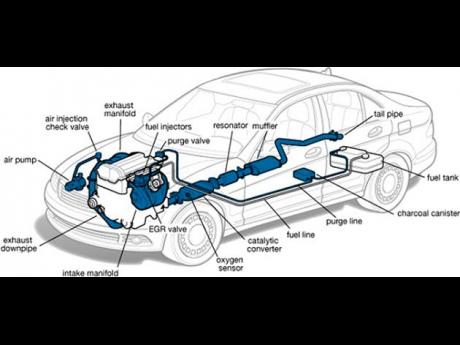What do you know about the fuel and exhaust systems?
The fuel system is made up of a fuel tank, fuel line, fuel pump, fuel filter, air cleaner, and carburettor.
“Some cars have a fuel-injection system instead of a carburettor,” says Andrew Brown, an experienced St Andrew-based auto mechanic. Fuel is pumped by the fuel pump from the tank through the fuel line and filter to the carburettor (which sits on top of the engine) or to the fuel-injection system. The carburettor mixes fuel with air drawn through the air cleaner and sends the mixture in a fine mist to each cylinder for combustion.
The exhaust system includes the exhaust pipe, catalytic converter (on most cars), muffler, and tailpipe. Exhaust gas passes through the muffler and out the tailpipe at the back of the car. Mufflers reduce noise from cylinder explosions. The catalytic converter reduces air pollution from car exhaust.
Points to note
1. The carburettor may need to be cleaned and adjusted for efficient use. The mechanic generally checks the carburettor at tune-up time.
2. The exhaust system needs replacement when some part of the system rusts through. Always ensure that the mechanic checks this system during routine servicing.
What causes exhaust gases to leak into the car?
1. Worn or missing grommets in the firewall.
2. Holes in the floor or holes in the trunk, allowing fumes to enter.
3. Exhaust manifold gasket blown or improperly installed.
4. Cracked exhaust manifold.
5. Worn heat-riser valve assembly.
6, Hole in muffler or tailpipe.
Exhaust pipe breaks at Manifold
1. Loose or broken motor mounts.
2. Pipe mounted too rigidly.
Exhaust smoking:
1. Black smoke indicates a rich fuel mixture, from malfunctioning carburettor.
2. Sticking choke.
3. Excessive fuel-pump pressure.
4. Blue smoke is caused by excessive engine-oil consumption.
5. White smoke is caused by condensation (normal for a few minutes in cold weather).
6. Leaking head gasket.
7. Cracked head or block.
Exhaust system noisy
1. Wrong muffler or one of inferior quality.
2. Bent muffler or tailpipe.
3. Cracked exhaust manifold.
4. Leak in any exhaust-system component.
5. Loose baffles in muffler.
6. Worn heat-riser valve assembly.
7. Blown exhaust tailpipe
8. Blown head gasket, allowing exhaust gases to escape between head and block.
Muffler or pipes fail frequently
1. Inferior components.
2. Excessive corrosion.
3. Severe road-salt conditions.
4. Constant damage by flying stones on road. Scraping on rutty roads. Loose motor mounts.
Flooding
There are many factors that could cause the carburettor to flood:
1. Excessive fuel pump pressure.
2. Dirt in gasolene or a gas-logged float (a hole or crack in the float will allow fuel to enter, and the float will sink, holding the needle valve wide open).
3. The float may also be improperly adjusted, automatic choke may be too rich, or the choke heat-control mechanism may be faulty.
4. A dirty plugged air filter will restrict the carburettor’s air intake.
5. Loose insulation from under the hood can drop down on to the air cleaner with a similar effect.
6. Sometimes the steel needle in the needle-and-seat assembly will become magnetised and attract particles of foreign matter, preventing proper seating.
“In some instances, the manufacturers have modified this needle, making it of neoprene or nylon to eliminate the problems of magnetism,” says Brown.
Worthy of note:
- A clogged carburettor air bleed can cause fuel to be siphoned from the carburettor when the engine is shut off. This floods the intake manifold and makes starting difficult.
– P.M.


